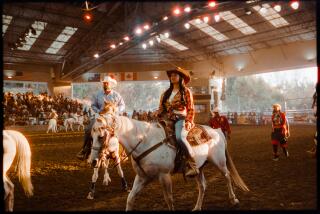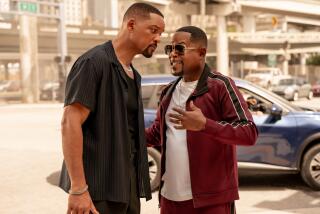Sam Peckinpah’s ‘The Wild Bunch’ killed the western dream, echoing the violence of 1969
- Share via
The heroes of the old American West lived by a simple moral code, at least in the movies. They were loyal to their friends and courageous in the face of danger. They were ready to fight on behalf of the weak — and the rule of law — against the powerful, greedy and cruel. As myths about the birth and virtue of the United States, the classic westerns were optimistic about the country and its future.
As the national mood changed during the social upheaval of the late 1960s, so did its westerns. By 1969 the war in Vietnam was going badly, and at home there was political turmoil, from student protests to assassinations. But nothing at the cinema, not even Sergio Leone’s spaghetti westerns, could have prepared the American public for Sam Peckinpah’s “The Wild Bunch,” a bloody tale of outlaws on the U.S.-Mexico border.
In honor of the film’s 50th anniversary, journalist W.K. Stratton has written an ambitious and lively history, “The Wild Bunch: Sam Peckinpah, a Revolution in Hollywood, and the Making of a Legendary Film.” He tells the story of how the movie was made and argues that it marked a turning point in American film history. It was, Stratton proclaims, “in most ways the last Western. With it Peckinpah destroyed all the standard stereotypes that made up cowboy pictures that came before it.”
Peckinpah always insisted that his movie was nothing more than “a simple story about bad men ... in changing times.”
Whatever happened to the old John Wayne movies?
— An audience member at a screening of Sam Peckinpah’s “The Wild Bunch”
The outline of the story is simplicity itself. After a botched bank raid, a gang of violent criminals flees across the Southern border, right into the middle of the Mexican Revolution.
Peckinpah found actors who looked their parts, or had even lived them. As the aging leader of the gang, Pike Bishop, Peckinpah cast William Holden, a fading film star. The role of Pike’s best friend, Dutch Engstrom, went to the WWII veteran Ernest Borgnine. The Gorch brothers were played by Warren Oates and Ben Johnson, the latter a stuntman and former rodeo cowboy. Unlike many other westerns that had Italians and Anglos play Mexicans, “The Wild Bunch” used mostly actors from Mexico. “The number of Mexicans in the picture dwarfed the number of Los Angeles gringos,” Stratton writes. But there was one exception. The Spanish-speaking Puerto Rican stage actor Jaime Sánchez played the part of a romantic but impulsive Mexican man, Angel. Peckinpah also cast well-known Mexican director and actor Don Emilio Fernández — who was known as “el Indio” due to his embrace of his indigenous heritage — as the general Mapache, who, Stratton reports, often carried a real pistol with him.
Even though it was a simple story, there was nothing simple about the long process of making it. At the heart of Stratton’s book are dozens of informative and colorful interviews, conducted with everyone from screenwriters and stuntmen to Hollywood producers and Mexican film stars. Stratton follows the cast and crew to the film’s primary location, the dusty Mexican state of Coahuila, where Sanchez quickly realized that something special was happening. “Sam made everybody feel that you go for broke,” recalled Jaime Sánchez. “Not to go for broke was an act of dishonor.”
Stratton also places the movie in its historical context. It was filmed and released during political unrest at home and an escalating war in Vietnam.
As he notes, “cast and crew settled into Mexico just days before the assassination of Martin Luther King, Jr.” During filming, American soldiers massacred hundreds of villagers in My Lai. A few months later, Robert F. Kennedy was assassinated. The old American myth of might in the service of right was becoming hard to believe. Instead, it seemed that “The Wild Bunch” reflected a country that was extremely violent and morally suspect. “The violence was exhilarating,” said Martin Scorsese, “but you felt ashamed for being exhilarated, mainly because it reflected what we were doing in reality in Vietnam, which we could see on the news at six o’clock at night.”
There was nothing simple about the movie’s themes either. The original screenwriter, Walon Green, wanted to upend the usual moralism and mythology of the West. “I’d read enough to know that Billy the Kid shot people in the back of the head while they were drinking coffee,” he told Stratton. Sure enough, Pike and his gang pay lip service to the old code but abandon it almost every time it becomes inconvenient. And bad as the bunch may be, law and modern civilization — represented by a rapacious American railroad executive and a vicious Mexican general — are even worse. When Angel tries to defend his native village against the general, he is captured. The rest of the gang then faces a stark choice. They must abandon a friend to certain death or finally live up to their ideals.
Unsurprisingly, the film polarized audiences and critics. After a preview in Kansas City, Missouri, one woman tried to have it censored by the Motion Picture Assn. of America. In Fresno, a group of nuns walked out of the theater during the opening bank robbery. “Whatever happened to the old John Wayne movies?” another audience member asked. And although some critics, including a young Roger Ebert, regarded the movie as a masterpiece, others sided with the nuns. One critic condemned it as an “ugly, pointless, disgustingly bloody film.” Another accused Peckinpah of nihilism, Stratton writes, of viewing “humanity as having no redeeming virtues, and therefore, should be blown away.”
The charge of nihilism misses the mark. Stratton convincingly argues that the film, far from being nihilistic, is in fact a tragedy. Yes, Pike and the gang betray the old code throughout the movie, but they ultimately resolve to rescue Angel from the general. “The end of the picture was just about the oldest chestnut in the book, to Peckinpah’s thinking,” writes Stratton. “That was what appealed to him about it.” Peckinpah wanted to know what kind of men would really have the courage to adhere to the old code, if only briefly. And what would happen to them if they did?
The answer, in the movie, is that they would die in one of the most gruesome gun battles in Hollywood history. Stratton regards their death as Peckinpah’s jeremiad against the “dystopia that would overtake the world during the twentieth century. Codes of honor destroyed, human value diminished.” The movie “howls against what has happened to mankind during modern times.” When the gang dies at the end of the film, the last vestiges of the old code seem to die with them. Stratton is certainly right about what Peckinpah was trying to say, but was Peckinpah right too?
Perhaps the real problem with “The Wild Bunch” was not nihilism but sentimental nostalgia, the belief that the old values of loyalty to your friends and a willingness to stand up for the weak have no place in the modern world. Though they looked different than Pike and the gang, King and Kennedy were taking a stand in the late 1960s. They died violent deaths too, but their deaths only meant that their ideals needed new champions. Fifty years later, we still need heroes.
::
“The Wild Bunch” author W.K. Stratton will sign books and take part in a conversation with Stephen Farber after a 50th anniversary screening of the film at 7 p.m. Tuesday at the Laemmle Playhouse.
Stratton will also appear for a conversation with three creative participants in the film at a screening at 7:30 p.m. Saturday at the Ahrya Fine Arts.
Get tickets and more info here.
::
“The Wild Bunch: Sam Peckinpah, a Revolution in Hollywood, and the Making of a Legendary Film”
W.K. Stratton
Bloomsbury Publishing: 352 pp., $28
Paul W. Gleason is an instructor in USC’s school of religion. He is a recent recipient of the National Book Critic Circle’s ‘emerging critic’ award.
More to Read
Sign up for our Book Club newsletter
Get the latest news, events and more from the Los Angeles Times Book Club, and help us get L.A. reading and talking.
You may occasionally receive promotional content from the Los Angeles Times.








